We have wanted to see more of Portugal than Lisbon (although we’ll never run out of things to do here) and we got a start on that by arranging a day trip to Sintra.
Sintra is a resort town in the foothills of the Sintra Mountains. Its weather is cooler than Lisbon’s in the summer in part because it is close to the Atlantic Ocean. Because of its history and the buildings and palaces found there, it is a UNESCO World Heritage Site. Remains from the Neolithic age have been found there.
We did not spend much time in the town, which is about a half-hour drive from Lisbon. Our guide, Alberto, gave us plenty of information about the area on the drive. As we drove through the town, we could see that it was packed with tourists. There are many places to visit there and it seemed to have plenty of places to eat. But we were intent on getting to Pena Palace (Palácio dos Pena).
Pena Palace is one of the highlights of Sintra. High on a hill (about 400 meters), it can be seen from far away and has an excellent view of the surrounding land. There had been a chapel on the spot since the Middle Ages. Around 1500, King Manuel I ordered a monastery to be built there. It was in ruins after lightning strikes and the Lisbon earthquake of 1755. King Ferdinand II decided to have it restored and expanded starting in 1838 to become a summer home for the royal family. It took about 10 years for the reconstruction and expansion.
Outside, the palace is striking. You will see in the pictures that the palace is vivid red and yellow. Those two colors show the old and new parts of the palace. We spent about 1/3 of our time outside in the various courtyards and climbing up and down. The views are great. It was a little windy. Good thing that I did not wear a hat because I am sure it would now be somewhere out over the Atlantic.
Inside, there was a well-marked tour path to follow. It did not go to every part of the castle, but we saw a lot. We were particularly impressed with the studies and bedrooms, the large kitchen, and, particularly, the chapel. The chapel dates back to the time well before the extensive damage and has a nice altar and retablo (if they call the decorations in back of an altar a retablo in Portugal). We enjoyed the tour and would probably spent more time there if we didn’t have other things to see.
Speaking of things to see, in addition to the Pena Palace one can see the ruins of the Castle of the Moors not too far away. Someday I would like to see if I can get a closer look.
After we left the palace we drove down the winding road back into Sintra. It must have been a real struggle to go back and forth 150 years ago, but we made it with only a couple of close calls on tight corners.
Alberto drove us through the town, pointing out more interesting places. We felt that we would be overwhelmed if we visited another palace: the Town Palace.
Instead, we decided to visit the gardens at Quinta da Regaleira. It was the summer residence of the Carvalho Monteiro family. It was built in 1904. There is a long story to go with the estate, but suffice it to say there was a lot of money involved and some social climbing and competition with the “noble” families. The gardens are true wonders. To quote from the brochure, “In these realms abound references to the worlds of mythology, to Olympus, Virgil, Dante, Milton and Camões”, etc. While I didn’t pick up on all of the references, I did enjoy wandering around in the gardens. One highlight of our visit was an excursion into what felt like an underground labyrinth. It felt like being in a dark sea cave and traversing tunnels. It appeared to be of natural construction but the rocks were cut from near the sea and transported to the garden. The residence, too elaborate to call a “house,” was a turn-of-the-century, rich person’s demonstration of wealth that was interesting, even though one cannot visit all 5 floors.
From Sintra, we drove through the country side to Cabo da Roca (Cape Roca), western-most point of land on continental Europe. What a vista! Our guide told us that on a clear day you can see the Statue of Liberty, but of course even he did not believe it. We walked down to where we could see the waves pounding against the granite cliffs. We were up pretty high but could still hear the surf. There is a lighthouse here that is pretty important. Smashing up against the cliffs would be bad news.
On the way from the cape to Cascais, we stopped at an old wind-driven grain mill. It still had the framework on which the sails–used to catch the wind–were mounted and which drove the millstone. Attached to the mill is a pretty nice café/restaurant. We all had good deserts and coffee. It made for a nice break after being on the go for quite a while.
Cascais is a resort town not too far from Lisbon. It is easy to reach from the big city and many people take a day trip here for the beaches, food, and shopping. We weren’t interested in 2 of the 3, but we did stop at a beach to see the Boca do Inferno (Hell’s Mouth) formation. You may have seen places like this along the coast in California or in Hawaii: a place along the shore that funnels the waves into a small area so there is a lot of crashing noise and spray. As our guide said, the name is overly dramatic, but it is a tourist attraction, after all. There was some noise and spray, but not enough that I could capture it in a video even though I tried several times.
From Cascais Alberto took the coast road into Lisbon and pointed out many interesting things. He wanted to be sure we felt that we got good value on our tour. Alberto was a good guide and a good ambassador for Portugal and we enjoyed our day with him.
We had a light meal at Memmo Alfama and stayed in for the evening.

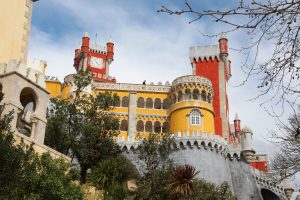
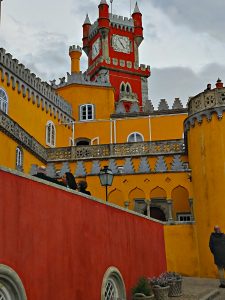
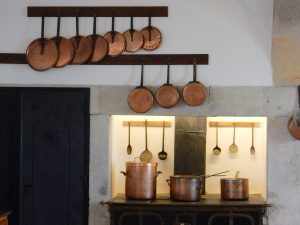
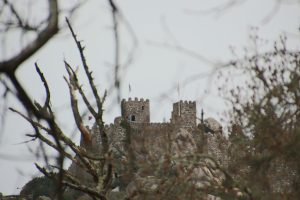
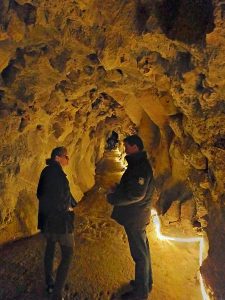

![A [former] wind-driven grain mill near Cascais](https://www.smoriarty.com/WP/wp-content/uploads/2017/03/S99003434-300x225.jpg)
